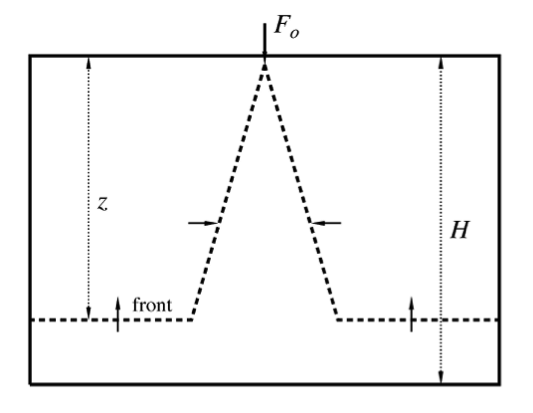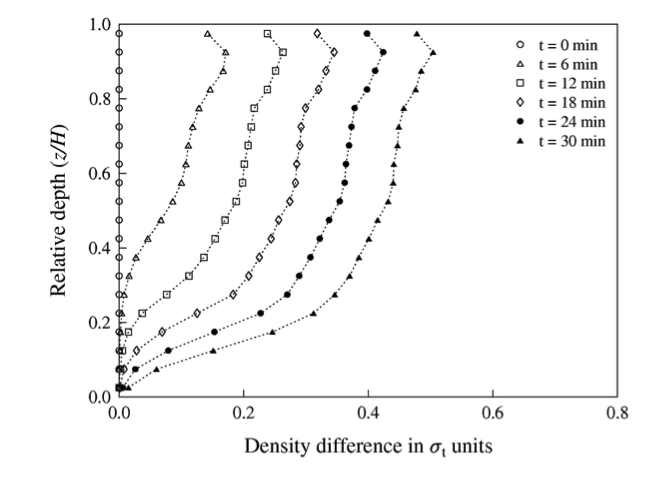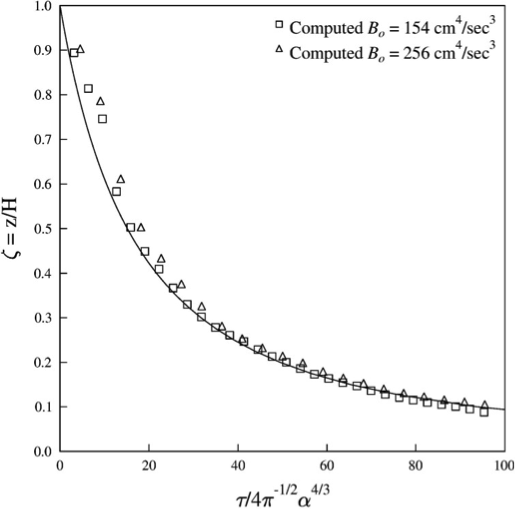|

Round Buoyant Jet in a Confined Region
Introduction
When a buoyant jet discharges into a confined region, the interaction between the jet and the surrounding water will result in a continuously changing ambient density profile. Baines and Turner (1969) carried out laboratory experiments with a negatively buoyant jet to study the effect of continuous convection on the properties of the environment when the region of interest is bounded. The dense plume mixes with the ambient fluid by turbulent entrainment; when it sinks to the bottom the mixed fluid spreads sideways as a bottom layer, with negligible vertical mixing (damped by density difference). The thickness of this layer of mixed dense fluid increases in depth with time, and the front of this bottom layer advances upwards (Fig. 1).

Figure 1. Experiment of negatively buoyant jet in a confined region.
Numerical Model
A vertical negatively buoyant jet (dense plume) is discharged into stagnant ambient fluid of initial uniform density ρa in a rectangular tank of length L=57 cm, width W=45 cm, and depth H=45 cm. The experiments were carried out with a nozzle of diameter D = 5 mm placed at H = 30 or 40 cm above the bottom of the tank, and about 0.5 cm below the initial free surface level. Kinematic buoyancy flux F0 = Q0gΔρ0/ρa(0) = 154 and 256 cm4/s3, where Q0 = discharge volume flux, were tested with the initial relative density difference Δρ0/ρa(0) = 0.13.
The interaction of the jet and the surrounding otherwise stagnant fluid is computed by dynamic coupling of a shallow water circulation model with the near field plume model (VISJET/JETLAG) embedded in the circulation model at grid cell level. The Distributed Entrainment Sink Approach (DESA) is used to model the action of the plume on the environment (Choi and Lee 2007). A 19 × 15 × 20 computational grid with horizontal grid size 3 cm × 3 cm and 20 uniform vertical layers is used to simulate the development of ambient density stratification with DESA. The model grid size is significantly greater than the jet diameter.
The two-way interaction between the buoyant jet and the surrounding fluid is illustrated in the video. As the ambient density increases due to the dense jet discharge, the jet concentration also rises as a result of jet entrainment. These features cannot be reproduced by alternative one-way coupling methods (Choi and Lee 2007). Figure 2 shows the ambient density profile changes from an initially uniform distribution to a stable stratification due to the action of the plume, and the computed interface (front) position is in excellent agreement with the best fit of experimental data (Fig.3). The DESA method has been successfully applied to many real life engineering problems.

Figure 2. Predicted ambient density profiles at x=5 Δx from the jet at different times after release of a buoyant source with F0 = 154 cm4/s3.

Figure 3. Computed time variation (τ = dimensionless time) of dimensionless interface position (symbols) by DESA. Solid line is best fit of experimental data represented by the analytical solution given in Baines and Turner (1969). (B0 = F0 = buoyancy flux).
Publications
- Choi, K.W. and Lee, J.H.W., (2007),"Distributed entrainment sink approach for modelling mixing and transport in the intermediate field", Journal of Hydraulic Engineering, ASCE, Vol. 133, No. 7, pp. 804-815.
- Lee, J.H.W. and Choi, D.K.W. (2008), "Real-time hydro-environmental modelling and visualization system for public engagement", Environmental Fluid Mechanics, Volume 8, pp.411-421.
- Lee, J.H.W., Wong, K.T.M., and Choi, K.W. (2013), "Forecasting and management of coastal water quality - issues and field operation experience", in Handbook of Environmental Fluid Dynamics, CRC Press, Fernando, H.J.S. (Ed.), pp. 75-90.

  
|